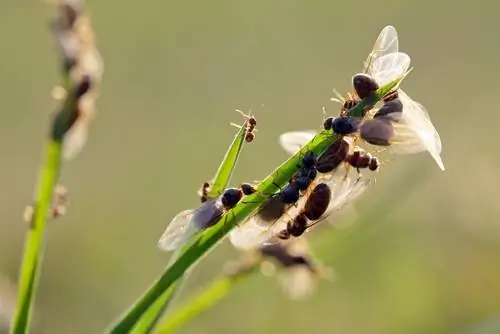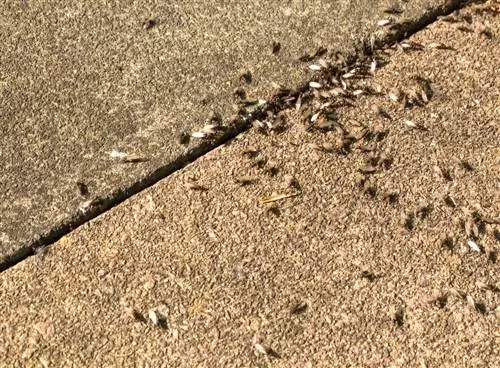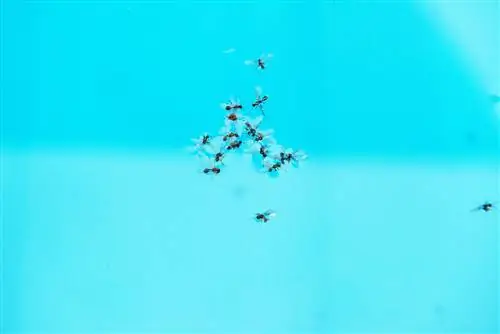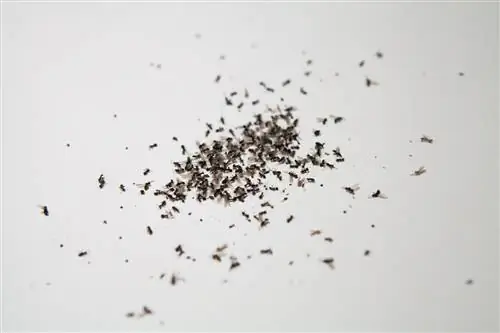- Author admin [email protected].
- Public 2023-12-16 16:46.
- Last modified 2025-06-01 06:02.
The classification of ants into the beneficial or pest category is not entirely clear. In addition to their useful properties, they also have a few harmful and, above all, annoying properties - especially when they fly out of the ground in thousands when they are winged.
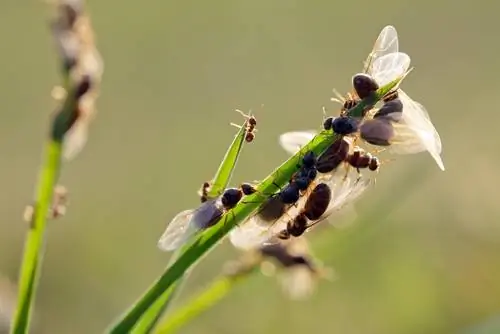
What to do against flying ants in the house or garden?
If flying swarms of ants are bothering you, the easiest way is to tolerate them. Because the nuptial flight only lasts about 2 to 3 days and only once a year, so you will soon have peace and quiet again. Instead of fighting the animals with great effort, you can just sit back and wait.
Of course not without parallel defensive measures. The most effective methods are purely physical barriers that prevent flying ants from entering the house:
- Insect gauze: By putting insect screens on your windows, you can prevent swarms of winged ants from getting into your bedroom or living room. At first glance, this seems disproportionately time-consuming for the few days of the nuptial flight - but if you don't want to be kept awake night after night by buzzing, biting mosquitoes or surprised by other swarming insects as the summer progresses, you'll benefit from it in the long term.
- Keep windows and doors closed: In summer, of course, you don't want to do without ventilation as much as usual. But if it can be set up somehow - for example by investing in air conditioning or when the weather is not so hot, the windows and doors should be kept as closed as possible during ant flight times.
- Lights off: This measure also generally helps against invading flying insects: Nocturnal beetles, moths, mosquitoes and even winged ants orient themselves towards light and are attracted to bright lighting in the house therefore strongly attracted. So if possible, do not leave lights on when windows or patio doors are open.
- Smell barriers: Ants find lemon juice and smells of cloves, cinnamon, chili, lavender or bay leaves repulsive. The smell of coffee is also said to have a repelling effect. For example, if you mix water with lemon juice, essential oils of the above-mentioned fragrances or strong espresso and pour the mixture into a water disperser, you can contain the flying pests right there and then.
- Vacuum cleaner: The vacuum cleaner can also be used to help against flying ants. A somewhat brutal method, but as a rule ants, even the winged ones, are very robust. What must of course be taken into account is to close the suction tube after the suction attack (e.g. with a fabric toggle) and empty the dust bag immediately at a distance.
- Ant sprays: Commercially available ant sprays are only suitable for flying ants insofar as their active ingredients can be sprayed and therefore easily applied to the nuisances in the air. The effect is usually very quick. However, the active ingredients are generally purely chemical and toxic not only to flying ants, but also to other animals, including your pets.
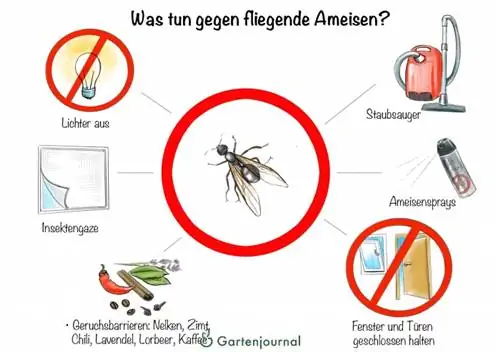
Prevent flying ants
In order to prevent flying ants from developing in your garden and thus easily getting into the house, it makes sense to look for ant nests in advance and eliminate them. In addition, ants can of course be a nuisance before and after the flight phase of the sexual animals due to their nest building and their everyday work in the state. Ant trails over the terrace and sometimes into the house are the most disturbing things. If they set up their nests under patio slabs, the undermining can also cause the paving bed to loosen and the slabs to sag.
If they crawl into the house en masse, it is of course annoying and possibly harmful because they can also decompose building materials here.
Ant Nest Disturbing: If you constantly level an ant nest in the lawn or in your patio paving and pour water over it, this will cause problems for the ants without killing them unnecessarily. They have enough to do getting their nest back in order and therefore less time to look after the brood.
Lime barriers: Alkaline substances such as chalk or garden lime also have an ant-repelling effect.
Bait: You can also capture ants using bait. The best lure is a cup of slightly stale beer sweetened with a spoonful of honey or sugar. If you place these over an ant trail, the animals will be magically attracted to the sweet, fermented smell. When they try to grab some of it, they fall in and drown.
Nematodes: Predatory nematodes are now recommended for many harmful insects. The predatory nematodes can also be used against ants by spreading them into the nests with irrigation water.
Relocate a nest: In contrast to wasp nests, an ant nest can be relocated easily and without expensive, professional help. All you need is a large terracotta flower pot with a drainage hole and some soil. And this is how it works:
- Fill the terracotta pot about four-fifths full with (sandy) soil or wood wool
- Place the pot near the ant nest, preferably directly above the path of an ant trail
- Wait until the animals discover the warm potting soil and crawl in through the drainage hole. They will recognize the flowerpot as an ideal breeding site and relocate their colony there. You can tell that this has happened by the numerous white dolls in the pot.
- Once the move is complete, pick up the pot from below with a shovel and transport it, if possible, without it falling over, for example to a nearby forest. The location should be at least half a kilometer away so that the ants cannot find their way back to their original nest.
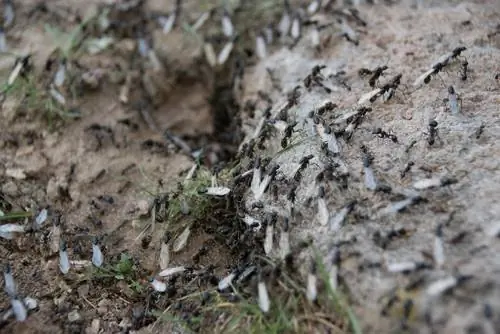
Ant colonies can be relocated relatively easily
Baking powder: Baking powder orBaking soda is an old home remedy against ants. Here too, the effect is based on the alkaline effect: it causes contact burns in ants. However, the method is not particularly reliable, and it also causes the ants a very unpleasant death. The method can be used poorly against flying ants, at most by sticking the powder with a little water to window and patio door frames during the flight phases. After the 2-3 day plague it can then be wiped off again.
What are flying ants?
Flying ants are sometimes considered a separate species. Because they resemble stinging insects when they are winged, some people may even have a vague fear that they could sting. But don't worry: flying ants are not dangerous. These are not a special species of ants, but only the sexual animals in the ant colony. And they are annoying at best.
Background
Wedding Flight
Young queens and males are winged in order to be as mobile as possible when looking for a partner. It's good to mate across countries. This is very similar to other colony-forming insects, such as some species of wasps.
The swarming of the sexual animals is also called “marriage flight” in ants. It usually takes place in early or mid-summer. The young queens and males then come together from colony to colony and start a real mating marathon. A young queen can be mated by up to 40 males and stores the sperm in a sperm sac.
After the nuptial flight, the swarming of ants is over: the males die immediately after completing their task, the young queens shed their wings again after use. The majority of the individuals in the ant colony, i.e. the workers, remain basically wingless.
Go to the ant, you lazy one; look at their ways and learn!
Ants - hard-working helpers and annoying swarmers
Ants should definitely be classified as beneficial insects for the garden. They effectively help in pest control and maintaining ecological balance. Here is a brief overview of the useful and harmful or annoying properties of ants:
| Beneficial properties | Pest characteristics |
|---|---|
| Sometimes eat pests such as leaf beetle larvae or butterfly caterpillars, as well as snail eggs | Defend aphids against predators (such as ladybirds) to eat their sweet honeydew |
| Transport dead plant material and insect carcasses | Form large, possibly disruptive swarms during the nuptial flight |
| Encourage the reproduction of certain trees through seed transport | It is not uncommon for them to nest near residential buildings - for example between paving stones on terraces and inner courtyards - risk of the paving becoming loose |
| Can also break into the house and become a burden there |
Background
Interesting facts about ants
Let's take a closer look at the amazing insect family of ants. The animals have been incredibly strong in survival since the Cretaceous period, not least because of their famous hard work. Already in the Bible it says in the book of Proverbs:
Ants belong to the order Hymenoptera - this already states that they can also have wings. They are very diverse and can be found almost all over the world: in total there are around 13.000 species that are native to temperate, tropical, subtropical, and sometimes even subarctic climate zones on all continents.
Unlike other hymenoptera, there are only social, i.e. colony-forming, ant species. Their colonies are well organized militarily and have therefore functioned admirably well for thousands of years. Above all, due to the clear division of labor within the caste system and the very mass-effective communication methods with scent trails and vibration signals, ants are among the most survivable species in the animal world.
Ants cover all possible diets across species: from omnivorous, predatory and scavenging, honeydew milking, seed collecting, thieving to mushroom growing types, everything is included.
Types of Flying Ants in the Garden
It is not possible to talk about all ant species here - and the majority of the species, which live primarily in tropical areas, have little relevance to our local gardening culture. In the following, we will therefore concentrate on the two species that like to populate our gardens in Central Europe: the black garden ant and the yellow meadow ant.
Black garden ant
The type of ant that is most commonly found in our gardens in this country is commonly referred to as a garden ant. And that is the black ant (zoological Lasius niger). It has a typical ant appearance with a 3-5 mm long, black, three-part segmented body. The queens reach a length of 8 to 9 centimeters.
Like many other ant variants, black ant ants are quite adaptable: They adopt different locations for their nest in a relatively undemanding manner: both in the lawn, under tree bark, vertically in cavities in masonry or in the spaces between patio and courtyard paving the animals settle in at home. The nest consists of passages and chambers and is reasonably stabilized by plant remains.
Yellow meadow ant
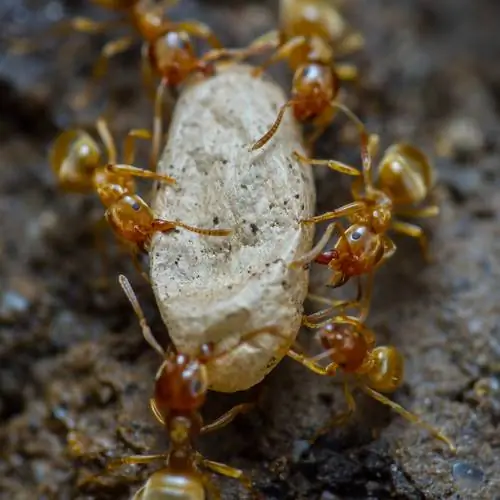
Yellow meadow ants are relatively small
But the much smaller yellow meadow ant, zoologically Lasius flavus, also likes to find itself in gardens in our latitudes. It is only about 2 to 4 ½ mm long and, as its name suggests, yellowish to reddish-brown in color.
The winged sexual animals, however, are significantly darker and also much larger - at least the queens are up to 9 mm long. This means that they can hardly be distinguished from the sexual animals of the black ants and, when they swarm out from their nest, they almost look like a different species compared to the small, yellow-red workers.
Red Meadow Ant
The red meadow ant nests primarily in the lawn. You can recognize their nests by hills overgrown with grass. The species tends to live primarily underground - they even get their food underground by keeping their own root lice colonies and milking their honeydew excretions. They therefore hardly have to go in and out and only become visible and noticeable in large numbers when their nest is destroyed - or when the flying ants phase begins. With this species, a plague of flying ants can quickly become a surprise.
Frequently asked questions
How many ants live in a colony?
This varies relatively depending on the species. In general, ants form very large colonies compared to other social hymenoptera. The black ant, our most common ant in the garden, can have up to 40,000 individuals living in one nest. But for other species there can be up to 20 million animals! Other species, on the other hand, live in cozy shared apartments with only about a dozen roommates.
The distribution within the so-called castes is comparable for all ant species, but how many individuals exist per cast varies. The queen caste in particular is sometimes only occupied by one full female, sometimes by several, sometimes by hundreds. In the case of the black ant, there are initially several queens, which are then reduced to one dominant one by fighting each other and by the workers. Males, which are winged their entire short life, are produced in only a few to a few hundred numbers. Their number depends on various factors, such as the size of the state, the age of the queen and some environmental conditions such as temperature, humidity and nest condition.
How long do ants live?
Among insects, ants are true Methuselahs. While many insect species have a life cycle of only one or two years, most ant species can reach double-digit years of life.
The most important ones in the state, the queens, always live the longest. The oldest known ant queen in a breeding facility is a proud 29 years old. The workers usually don't live that long, but in larger species they usually live for several years. As with most insect species, males have the shortest lives: they are only needed for mating and therefore only exist for the reproductive phase.
The sexual animals only stay in their phase as flying ants for 2 to 3 days. The males then die and the young queens shed their wings again.
Can flying ants be dangerous?
No, flying ants are the least dangerous members of the ant colony for us humans. Even though, with their significantly larger shape and wings compared to other ants, they almost look like small stinging insects. But they are actually completely harmless because they concentrate primarily on their task of reproduction. Guarding the nest is the responsibility of the workers, also known as “soldiers”. This name already shows that you have to be careful of them rather than the flying ants buzzing around in a frenzy of love.
The workers only bite when the nest is attacked. This can be quite painful. As long as there are only individual bites, these ant attacks are not critical. However, it becomes problematic if you are covered in bites, bites occur in the mouth or intimate area and/or the person bitten has an allergy to insect venom. Then medical attention should be sought immediately.
Why does the death of the queen mean the end of an ant colony?
If the queen dies of old age or a fan of the increasingly popular hobby ant breeding collects her for his own purposes, there is no one left to reproduce and produce colony-maintaining sex animals. The workers do not have sufficiently developed sexual organs and cannot replace the role of the queen. A generation of sexual animals, i.e. flying ants, can then no longer be produced. This means that a state can never be older than the queen.
Is a plague caused by flying ants a reason for a rent reduction?
Not at first. Especially if it's just a few animals buzzing through the window like flying ants, there is no right to a rent reduction. Only when the plague reaches such proportions that the house is no longer habitable can a rent reduction be made possible. This definition is of course very vague and must always be assessed on a case-by-case basis.
In general, however, the following applies: Any causes caused by the tenant must be ruled out - for example, negligent luring by leaving windows and doors open at night while the lights are on at the same time. In any case, the landlord must first be given the opportunity to resolve the problem. As a rule, however, it must be expected that lawsuits will be dismissed due to the reasonableness of such a completely natural burden on life.

